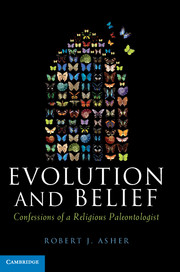Book contents
- Frontmatter
- Contents
- Acknowledgments
- Prologue
- One Science and Religion
- Two Evolution as a Science
- Three Characters and Common Descent
- Four The Fossil Record
- Five The Roots of Mammals
- Six A Brief History of Elephants
- Seven Whales are no Fluke
- Eight Creationism
- Nine DNA And The Tree pf Life
- Ten DNA and Information “Creation”
- Eleven Biology and Probability
- Twelve Evolution, Education, and Conclusions
- Notes
- Bibliography
- Index
Four - The Fossil Record
Published online by Cambridge University Press: 05 March 2012
- Frontmatter
- Contents
- Acknowledgments
- Prologue
- One Science and Religion
- Two Evolution as a Science
- Three Characters and Common Descent
- Four The Fossil Record
- Five The Roots of Mammals
- Six A Brief History of Elephants
- Seven Whales are no Fluke
- Eight Creationism
- Nine DNA And The Tree pf Life
- Ten DNA and Information “Creation”
- Eleven Biology and Probability
- Twelve Evolution, Education, and Conclusions
- Notes
- Bibliography
- Index
Summary
One of the most powerful means by which scientific inquiry can confirm a hypothesis is the congruence of data from different sources toward a common answer. We’ve just reviewed above some of the comparative anatomy (the study of the skeleton, teeth, limbs, organs, etc. across animal groups) that biologists use to show how vertebrates share common ancestry. Monkeys and humans are closer to one another than either is to a galago, and these three in turn share more recent common ancestry among each other than any does with a kangaroo. All mammals are more closely related to one another than any is to a crocodile, and so on, reflecting the branching structure shown in Figure 3.1. This broad-scale theory of genealogical relations among animals was initially proposed on developmental and anatomical evidence. Now, we know that completely independent bodies of data from the fossil record and molecular biology have also lent support to this theory of interrelationships.
The pattern of genealogical relationships shown in Figure 3.1 has been articulated by many biologists with substantial consistency, in some cases before and more frequently after publication of On the Origin of Species. Pre-Darwinian biologists such as the Swedish taxonomist Carl Linnaeus or the French anatomist Georges Cuvier did not have a robust causal mechanism, or process, to explain what they observed in terms of shared features across plants and animals, or pattern. Nonetheless, Linnaeus and Cuvier (and anti-Darwinists such as Richard Owen or Louis Agassiz) were perfectly capable of observing the pattern left behind by evolution. They knew that some animals resemble each other in many ways despite living in very different environments (such as seals and cats, or hippos and camels). While they did not understand the process behind these patterns of resemblance, non-Darwinian taxonomists were aware of the patterns and even incorporated them into their classifications.
- Type
- Chapter
- Information
- Evolution and BeliefConfessions of a Religious Paleontologist, pp. 63 - 88Publisher: Cambridge University PressPrint publication year: 2012



